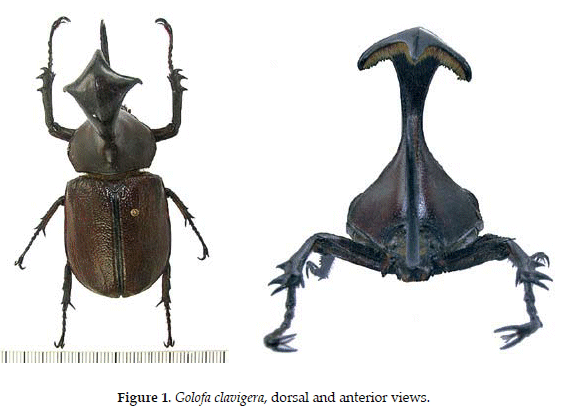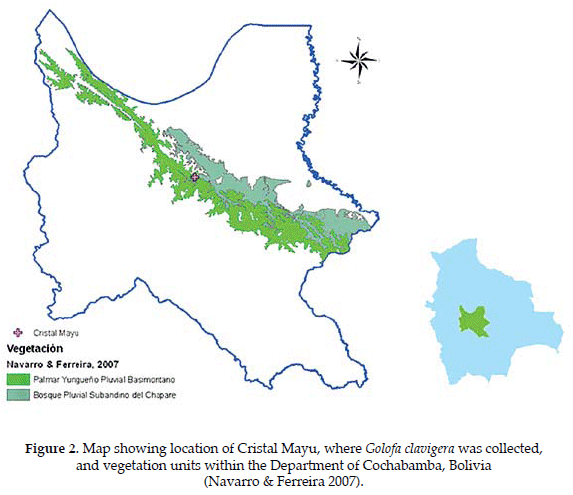Ecología en Bolivia
versión impresa ISSN 1605-2528versión On-line ISSN 2075-5023
Ecología en Bolivia v.45 n.1 La Paz abr. 2010
Nota
Golofa clavigera (Linnaeus, 1771) in Bolivia: a new country record (Coleóptera: Scarabaeidae: Dynastinae)
Golofa clavigera (Linnaeus, 1771) en Bolivia: Un nuevo registro para el país (Coleoptera: Scarabaeidae: Dynastinae)
Ariel A. Céspedes1* & Brett C. Ratcliffe2
1Museo de Historia Natural Alcide d'Orbigny, Casilla 4324, Av. Potosí No. 1458, Cochabamba, Bolivia email: scotigera@gmail.com *autor de correspondencia
2Systematics Research Collections, W436 Nebraska Hall, University of Nebraska Lincoln, NE 68588-0514 U.S.A. email: bratcliffe1@unl.edu
Members of the tribe Dynastini are among some of the largest and heaviest insects on Earth. In addition to being among the largest, some species, such as the Neotropical hercules beetles (Dynastes species), Neotropical elephant beetles (the larger species of Megasoma) and the Neotropical sawyer beetles (the larger Golofa species) have some of the most fantastic horns seen in the animal kingdom. Sexual dimorphism is well-developed in most species of Dynastini, and males of some species have huge and/or bizarrely-shaped horns on the head and pronotum, while the females lack horns.
There are 27 species in the Neotropical genus Golofa Hope, 1837 (Lachaume 1985; Morón 1995; Ratcliffe 2003a). Species are found from central Mexico to northern Argentina and Chile. Thirteen species are found in Central America, and 14 species are found in South America. Bolivia has previously been known to be home to only two species (Lachaume 1985).
Adult males of most of the South American species may be recognized by their brownish yellow to dark reddish brown color; the presence of a long, upright, slender head horn; the usual presence of a short to long, erect or obliquely oriented pronotal horn; and mandibles either entire or weakly incised at the apex. Golofa females are yellowish brown to more commonly black, and they lack any horns.
In spite of modern synopses (Endródi 1977, 1985, Dechambre 1983, Lachaume 1985, Morón 1995), identification of many of the species of Golofa remains difficult, because there is significant morphological variation in male secondary sexual characters combined with an unusual (for dynastines) lack of differentiation of the male genitalia. In many cases, moreover, females can be identified only by being collected simultaneously with conspecific males.
The larvae of only two species of South American Golofa have been described: that of G. porteri Hope, 1837 and of G. eacus Burmeister, 1847 (Morón 1994, 1995). The larva of G. clavigera has not been described.
Adults of most species are nocturnal, and they are sometimes, but not always, attracted to light. Howden and Campbell (1974) observed G. porteri Hope in Colombia during the day on bamboo or a bamboo-like grass; males were actively feeding, and some were engaged in fighting one another on the bamboo stalks. A few specimens, particularly females, were taken at lights. We know virtually nothing about the biology of these large beetles.
Golofa clavigera (L.) in Bolivia
Golofa clavigera (Figs. 1-2) is a fairly common beetle (Lachaume 1985) in French Guiana, Venezuela, Brazil (Pará State), Colombia, Ecuador, and Peru (Dechambre 1983, Endródi 1985, Lachaume 1985). Here we report the first known specimen from Bolivia that represents a new national record (Fig.1).

BOLIVIA: Cochabamba, Cristal Mayu (Chapare) (Fig. 2), collected at light in the forest near Cristal Mayu, 17.000991°S, 65.646468°W, 688 m, I-10-2009, Walker Peredo Montano collector. The specimen is a major male measuring 473 mm in length and is deposited in the collection of the Museum of Natural History Alcide d'Orbigny in Cochabamba, Bolivia.

The town of Cristal Mayu belongs to the municipality of Villa Tunari (Cochabamba:Municipality of Chapare) at 17.001419° S, 65.636159° W. It is 136 km NE of the city of Cochabamba. The area is a high basin containing the Ichilo River in the Department of Cochabamba. According to Navarro & Ferreira (2007), this area is comprised of tropical Andean rain forest (Yungas) with indicator species Heliocarpus americanus (L.) (Tiliaceae) and Inga aff. nobilis Willdenow as well as subandean wet forest (Amazonian) with indicator plants Elaeagia obovata Rusby (Rubiaceae) and Talauma boliviana M. Nee (Magnoliaceae). Cristal Mayu is located almost at the interface of these two habitat types (Fig. 2).
There are also unpublished records of this species in Bolivia. There are four males and one female of G. clavigera collected in January 1990 from the northern Yungas of La Paz (Bolivia) in the personal collection of R.-P. Dechambre, Paris, France (G. Lachaume, pers. comm., 2010).
The Cristal Mayu specimen represents a southward extension into Bolivia of the previously known range of G. clavigera. Discoveries like these, combined with the well-documented threats to tropical habitats globally, add importance to conducting extensive field studies and faunistic surveys in Bolivia. Collection of new material and identification of existing collections are needed in order to explore and catalog biotic diversity and to facilitate further research. Research infrastructure will be enhanced in Bolivia by collaborative activities such as this one, establishment of authoritatively identified collections, creation/ augmentation of databases, and future partnerships to explore biodiversity. Results should be available to researchers, Bolivian students at all levels, natural resource managers, government entities, and amateur naturalists. Benefits to society would include a better understanding of the importance of and threats to biodiversity, enhanced ability to monitor habitats (conservation, invasive species, pest species) using taxonomic knowledge, educating students and the public about science, training future scientists or technicians, and instilling in the people of Bolivia a sense of responsibility and pride in their own rich biota so they may better care for it.
Acknowledgments
We thank the Museum of Natural History Alcide d'Orbigny, Ricardo Céspedes Paz and Gilberth Lachaume for their unconditional support of this study. Walker Peredo Montaño is gratefully acknowledged for his continuing contributions to the collection. This report was supported, in part, by a Biotic Survey and Inventory grant from the National Science Foundation (DEB0716899) to B. C. Ratcliffe and R. D. Cave.
References
Dechambre, R.-P. 1983. Le genre Golofa (Col. Dynastidae). Bulletin de la Société Sciences Nat (37): 1-11. [ Links ]
Endródi, S. 1977. Monographie der Dynastinae (Coleoptera) 6. Tribus Dynastini. II. Acta Zoologica Academiae Scientiarum Hungaricae 23: 37-86. [ Links ]
Endródi, S. 1985. The Dynastinae of the World.Dr. W. Junk Publisher, Dordrecht. 800 p. [ Links ]
Howden, H. F. & J. M. Campbell. 1974. Observations on some Scarabaeoidea in the Colombian Sierra Nevada de Santa Marta. Coleopterists Bulletin 28:109-114. [ Links ]
Lachaume, G. 1985. Dynastini 1: Dynastes -Megasoma - Golofa. Les Coléoptéres du Monde 5. Sciences Nat, Venette. 85 p. [ Links ]
Morón, M. A. 1994. Larvae and pupae of two species of Golofa Hope (Coleoptera: Melolonthidae, Dynastinae) from Colombia. Coleopterists Bulletin 48:390-399. [ Links ]
Morón, M. A. 1995. Review of the Mexican species of Golofa Hope (Coleoptera: Me lo lo nthid ae, Dynastinae ) .Coleopterists Bulletin 49: 343-386. [ Links ]
Navarro, G. & W. Ferreira. 2007. Mapa de vegetación de Bolivia. CD-ROM Interactivo. The Nature Conservancy & Rumbol, Cochabamba. [ Links ]
Ratcliffe, B. C. 2003. The dynastine scarab beetles of Costa Rica and Panama (Coleoptera: Scarabaeidae: Dynastinae). Bulletin of the University of Nebraska State Museum 16: 1-506. [ Links ]
Nota recibida en: Noviembre de 2009.
Manejada por: Diana Silva
Aceptada en: Febrero de 2010.












 uBio
uBio 

